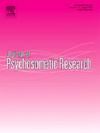中年早期残疾养老金的气质与风险:对1966年芬兰北部出生队列的22年随访研究
IF 3.5
2区 医学
Q2 PSYCHIATRY
引用次数: 0
摘要
目的探讨气质特征、个体对刺激反应的生物学倾向是否能预测残疾养老金。方法对1966年芬兰北部出生队列研究对象(n = 4713)进行31岁时的气质特征(寻求新奇、避免伤害、奖励依赖和坚持)调查。我们使用Cox回归来计算52岁之前的事故残疾养老金的风险比及其95%置信区间,这些数据来自国家登记册。潜在的协变量包括婚姻状况、教育程度、工作类型、平均工资、感知健康状况、31岁时的精神障碍和肌肉骨骼诊断。结果在22年的随访中,我们记录了412份残疾养老金(男性163份,女性249份)。较高的伤害规避增加了男性和女性的残疾养老金风险,风险比(95%置信区间)分别为1.05(1.02-1.07)和1.05(1.03-1.08)。伤害回避、奖励依赖和新奇寻求的部分分量表也能预测伤残抚恤金。结论较高的伤害回避及其分量表预测了22年随访期间直至成年中期的残疾养老金,尽管影响相对较小。本文章由计算机程序翻译,如有差异,请以英文原文为准。
Temperament and risk of disability pensions in early middle age: A 22-year follow-up study of the northern Finland birth cohort 1966
Objectives
We examined whether temperament traits, individual biological tendencies to react to stimuli, predict disability pensions.
Methods
We surveyed the temperament traits (novelty seeking, harm avoidance, reward dependence and persistence) of the Northern Finland Birth Cohort 1966 Study participants (n = 4713) when they were 31 years of age. We used Cox regression to calculate the hazard ratios and their 95 % confidence intervals for incident disability pensions until the age of 52, which we obtained from national registers. Potential covariates included marital status, education, work type, average wage, perceived health, and mental disorder and musculoskeletal diagnoses at the age of 31.
Results
We recorded 412 disability pensions (163 for men and 249 for women) during the 22-year follow-up. Higher harm avoidance increased the risk of disability pension with a hazard ratio (95 % confidence interval) of 1.05 (1.02–1.07) and 1.05 (1.03–1.08) for men and women, respectively. Some subscales of harm avoidance, reward dependence and novelty seeking also predicted disability pension.
Conclusions
Higher harm avoidance and its subscales in particular predicted disability pensions in a 22-year follow-up period up to mid-adulthood, although the impact was relatively modest.
求助全文
通过发布文献求助,成功后即可免费获取论文全文。
去求助
来源期刊
CiteScore
7.40
自引率
6.40%
发文量
314
审稿时长
6.2 weeks
期刊介绍:
The Journal of Psychosomatic Research is a multidisciplinary research journal covering all aspects of the relationships between psychology and medicine. The scope is broad and ranges from basic human biological and psychological research to evaluations of treatment and services. Papers will normally be concerned with illness or patients rather than studies of healthy populations. Studies concerning special populations, such as the elderly and children and adolescents, are welcome. In addition to peer-reviewed original papers, the journal publishes editorials, reviews, and other papers related to the journal''s aims.

 求助内容:
求助内容: 应助结果提醒方式:
应助结果提醒方式:


